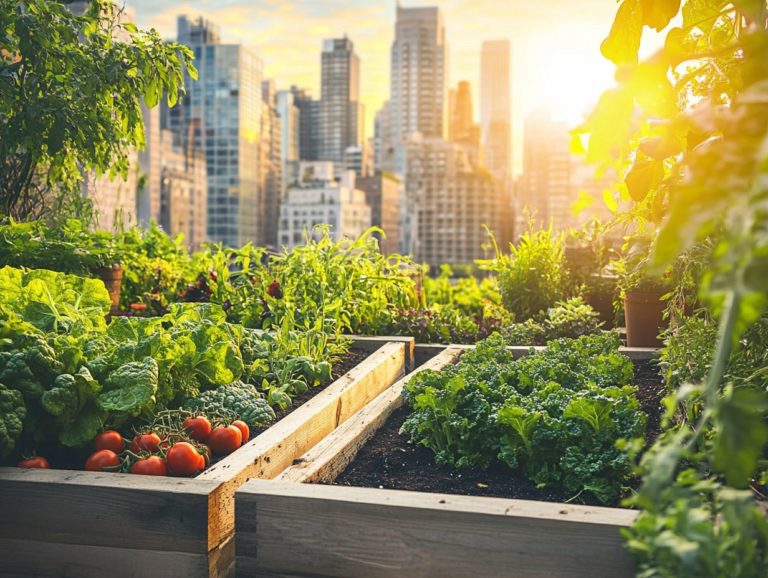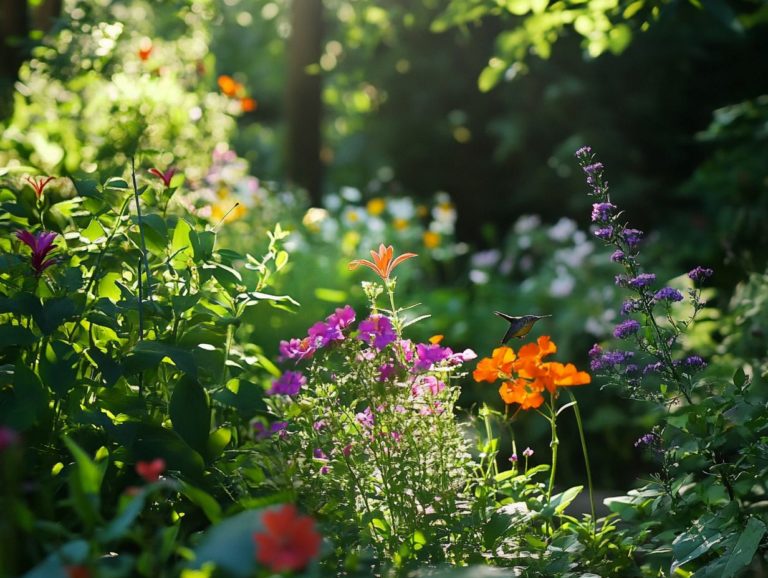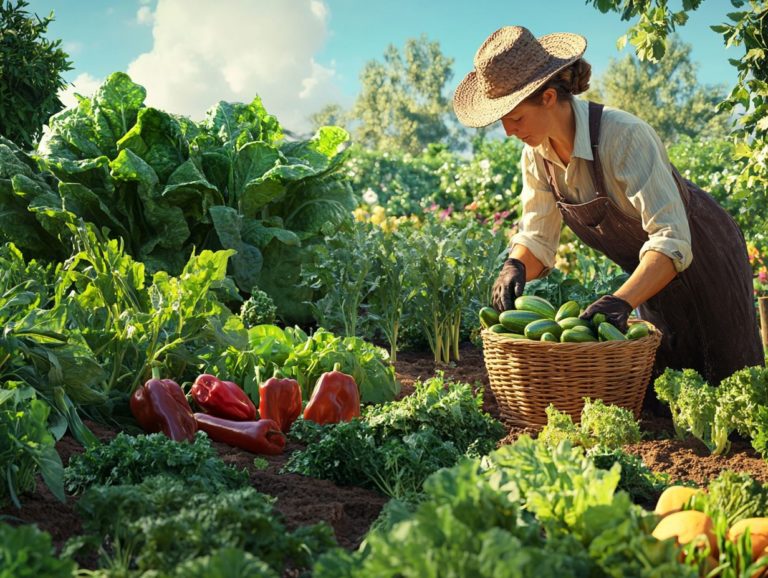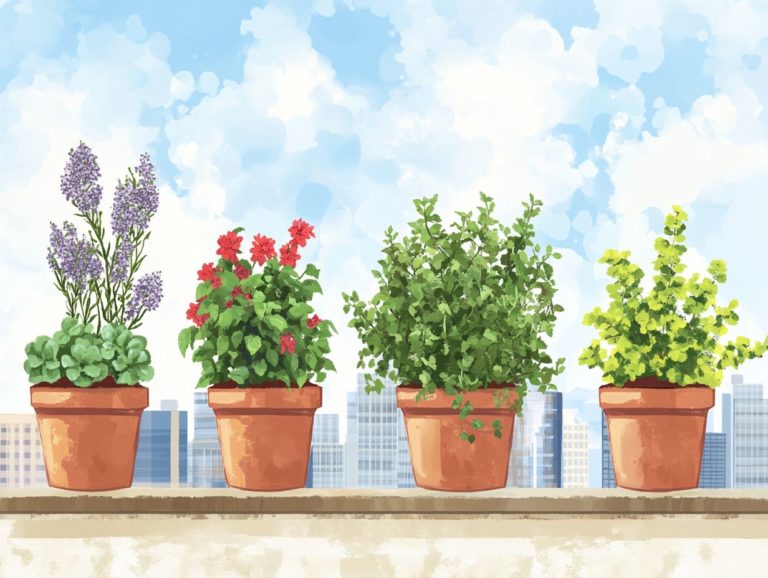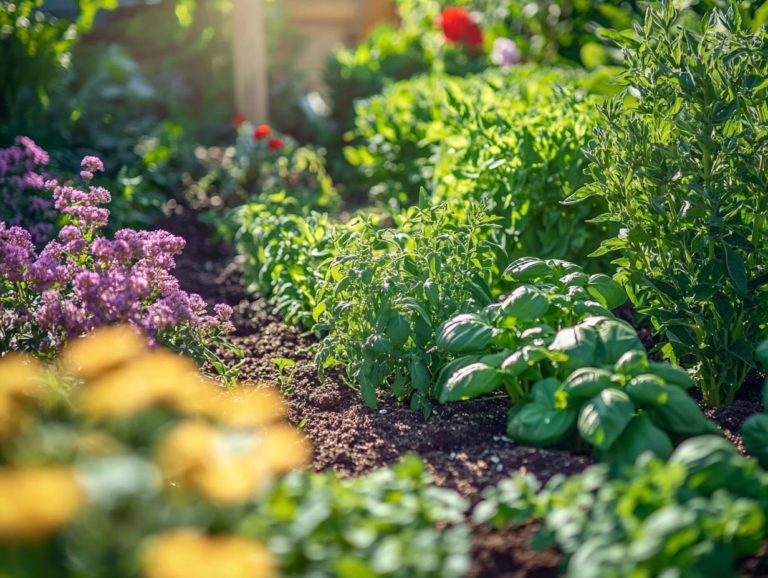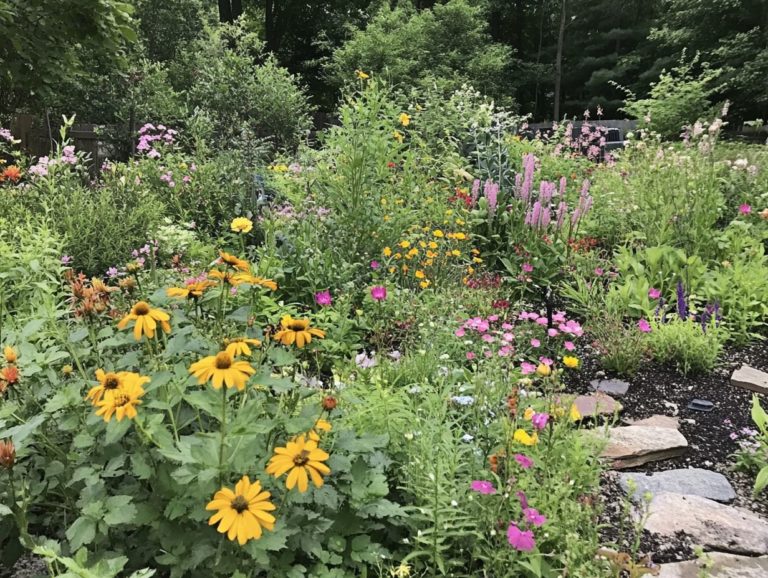“Top Plants for a Sustainable Urban Landscape”
Discover how you can transform your city with vibrant plants that make a difference! Creating a sustainable urban landscape is becoming essential as cities expand and natural spaces diminish. This guide invites you to explore a diverse array of plants that enhance the beauty of urban environments and contribute to ecological balance.
From native and drought-tolerant species to edible and air-purifying plants, you’ll discover how these green allies can turn concrete jungles into vibrant, eco-friendly havens. Dive into practical tips and insights for cultivating a sustainable garden right in your own city, and embrace the transformative power of nature in your urban setting.
- Key Takeaways:
- 1. Native Plants for a Sustainable Urban Landscape
- 2. Drought-Tolerant Plants for a Sustainable Urban Landscape
- 3. Perennial Plants for a Sustainable Urban Landscape
- 4. Edible Plants for a Sustainable Urban Landscape
- 5. Low-Maintenance Plants for a Sustainable Urban Landscape
- 6. Shade-Tolerant Plants for a Sustainable Urban Landscape
- 7. Air-Purifying Plants for a Sustainable Urban Landscape
- 8. Pollinator-Friendly Plants for a Sustainable Urban Landscape
- 9. Vertical Gardening for a Sustainable Urban Landscape
- 10. Container Gardening for a Sustainable Urban Landscape
- Get Started on Your Urban Garden Today!
- 11. Rain Garden Plants for a Sustainable Urban Landscape
- 12. Ground Cover Plants for a Sustainable Urban Landscape
- 13. Native Grasses for a Sustainable Urban Landscape
- 14. Medicinal Plants for a Sustainable Urban Landscape
- 15. Ornamental Plants for a Sustainable Urban Landscape
- What Makes a Plant Sustainable for an Urban Landscape?
- Frequently Asked Questions
- What are the top plants for a sustainable urban landscape?
- Why are native plants important for a sustainable urban landscape?
- Which drought-resistant plants are suitable for an urban environment?
- How do plants attract pollinators in an urban landscape?
- What other benefits do plants provide in a sustainable urban landscape?
- How can I incorporate these plants into my own urban landscape?
- Choose native plants for a sustainable urban landscape that supports local ecosystems and reduces maintenance needs.
- Opt for drought-tolerant plants to conserve water and reduce the need for irrigation in urban environments.
- Incorporate perennial plants into your urban landscape to reduce the need for replanting and promote long-term sustainability.
Contents
Key Takeaways:
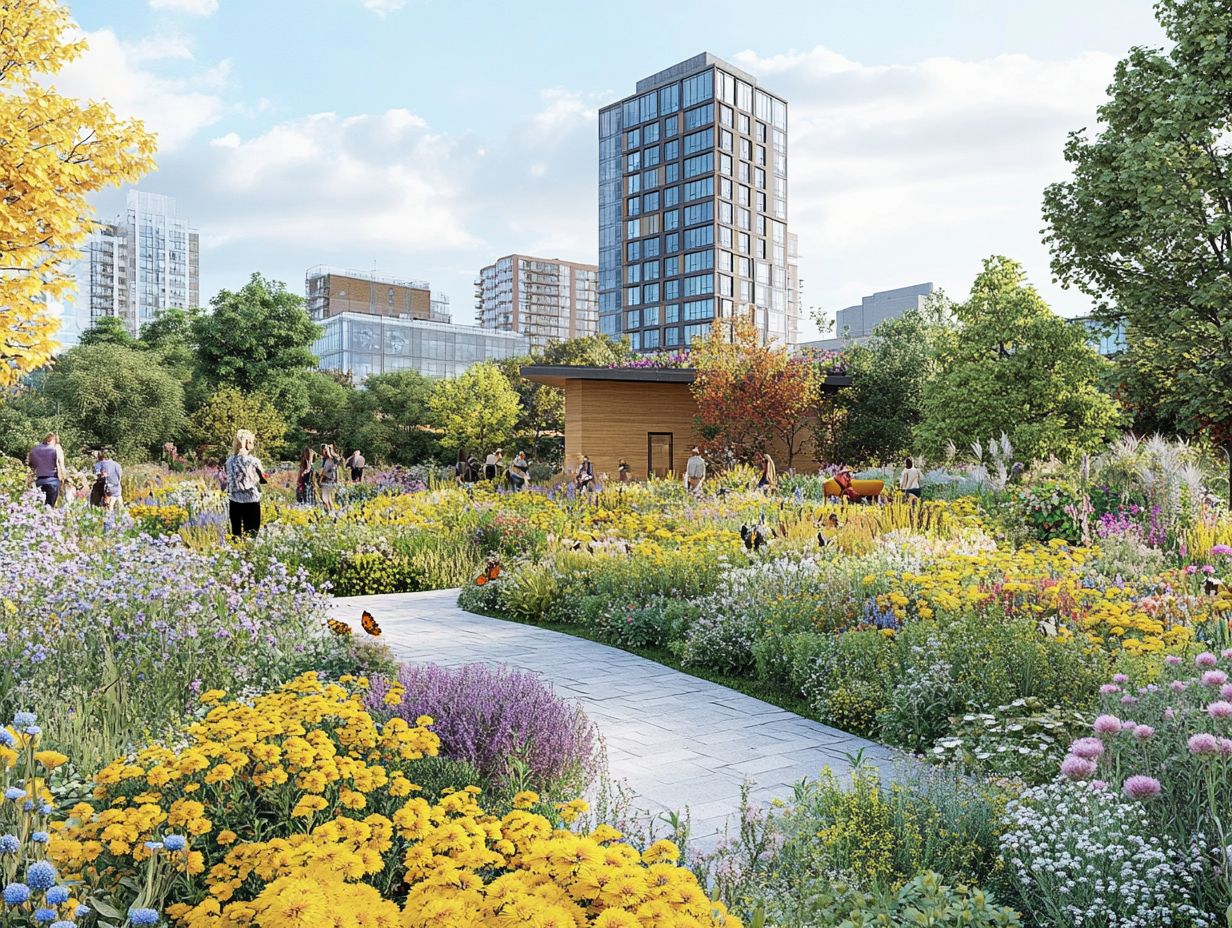
1. Native Plants for a Sustainable Urban Landscape
Incorporating native plants into urban landscapes enhances biodiversity and helps cities adapt to climate change. These plants are uniquely adapted to local conditions, requiring less maintenance and reducing the need for chemical fertilizers. They support essential bees and butterflies, cultivating a thriving ecosystem within urban areas.
Specific native species, like coneflowers, black-eyed Susans, and dogwoods, add beauty to community streetscapes and serve crucial roles in local ecosystems. Their presence can improve air quality by absorbing pollutants and releasing oxygen. They also provide essential habitats for birds and beneficial insects.
By integrating these plants into your urban gardening and landscaping efforts, you can enjoy energy savings through natural shading and cooling. This reduces reliance on air conditioning. The collective impact of such native flora promotes a vibrant urban ecology, creating healthier living spaces for residents while supporting local wildlife.
2. Drought-Tolerant Plants for a Sustainable Urban Landscape
Drought-tolerant plants play a vital role in creating sustainable urban landscapes, especially in areas grappling with climate change and water scarcity. They require minimal irrigation while delivering both aesthetic appeal and environmental benefits.
Standout options include succulents, ornamental grasses, and native perennials, known for their resilience and low maintenance requirements. By incorporating these plants into your landscape, you’re not just conserving precious water resources; you’re also enriching urban ecosystems by providing habitats for local wildlife.
Their remarkable ability to mitigate urban heat is invaluable. These plants also stabilize the soil, combating erosion effectively and reinforcing ground integrity.
Integrating drought-tolerant species into your landscaping enhances practices, resulting in vibrant, visually appealing designs that showcase your commitment to eco-friendliness.
Act now to create a greener future!
3. Perennial Plants for a Sustainable Urban Landscape
Perennial plants are essential for cultivating sustainable urban landscapes. They provide long-term solutions that enhance soil quality, boost biodiversity, and lower maintenance costs compared to annual plants.
These resilient plants require less replanting. They also create essential habitats for pollinators and local wildlife, nurturing a balanced ecosystem right in your urban environment. Perennials significantly improve air quality by absorbing pollutants and releasing oxygen, ultimately enhancing your living conditions in the city.
When thoughtfully integrated into urban development think community gardens or green roofs these plants can flourish in a variety of settings.
To make the most of their benefits, focus on best practices such as:
- Selecting drought-tolerant species
- Ensuring proper soil preparation
- Utilizing native plants that already support local fauna
This approach creates harmony between nature and city life.
4. Edible Plants for a Sustainable Urban Landscape
Integrating edible plants into urban landscapes not only champions sustainable agriculture, but also injects economic vitality into local communities by enhancing food security and fostering community engagement.
This approach opens up a world of edible possibilities, including herbs, vegetables, and fruits that flourish in even the tightest of spaces. Beyond their nutritional benefits, these plants serve as a source of mental well-being, offering therapeutic activities that alleviate stress and boost overall happiness.
Urban agriculture practices like vertical gardening, which involves growing plants upwards to save space and enhance beauty, and repurposing underutilized areas, can be adeptly employed to maximize growth potential. Community gardening initiatives play a pivotal role in bolstering local economies, creating job opportunities, and encouraging collaboration among residents. This ultimately cultivates a profound sense of belonging and ownership within neighborhoods.
5. Low-Maintenance Plants for a Sustainable Urban Landscape
Low-maintenance plants are essential for crafting sustainable urban landscapes that are not only eco-friendly but also accessible to communities with limited resources or gardening experience.
These plants demand minimal watering and care, providing significant cost savings over time by reducing the need for extensive landscaping services. Varieties such as sedums, ornamental grasses, and native wildflowers flourish in urban settings, bringing vibrant colors and textures while attracting beneficial pollinators. Their resilience aligns with environmental goals, improving air quality and managing stormwater runoff while enhancing the visual appeal of public spaces.
Imagine transforming our cities with low-maintenance plants! These options can create vibrant green spaces that foster community engagement and promote biodiversity.
6. Shade-Tolerant Plants for a Sustainable Urban Landscape
Shade-tolerant plants play a crucial role in creating sustainable urban landscapes. They help moderate temperatures, enhance air quality, and improve overall comfort in crowded city environments.
By incorporating these plants into your city designs, you cultivate inviting green spaces while significantly decreasing reliance on energy-hungry air conditioning systems, as they naturally cool buildings. Species like ferns, hostas, and certain types of ivy thrive in shaded areas, making them ideal for urban gardens and parks. Their leafy canopies serve as natural insulators, filtering pollutants from the air and contributing to a healthier ecosystem.
These plants also support local biodiversity by providing habitat and food sources for a variety of insects and birds. This ultimately fosters a more balanced urban ecosystem.
7. Air-Purifying Plants for a Sustainable Urban Landscape
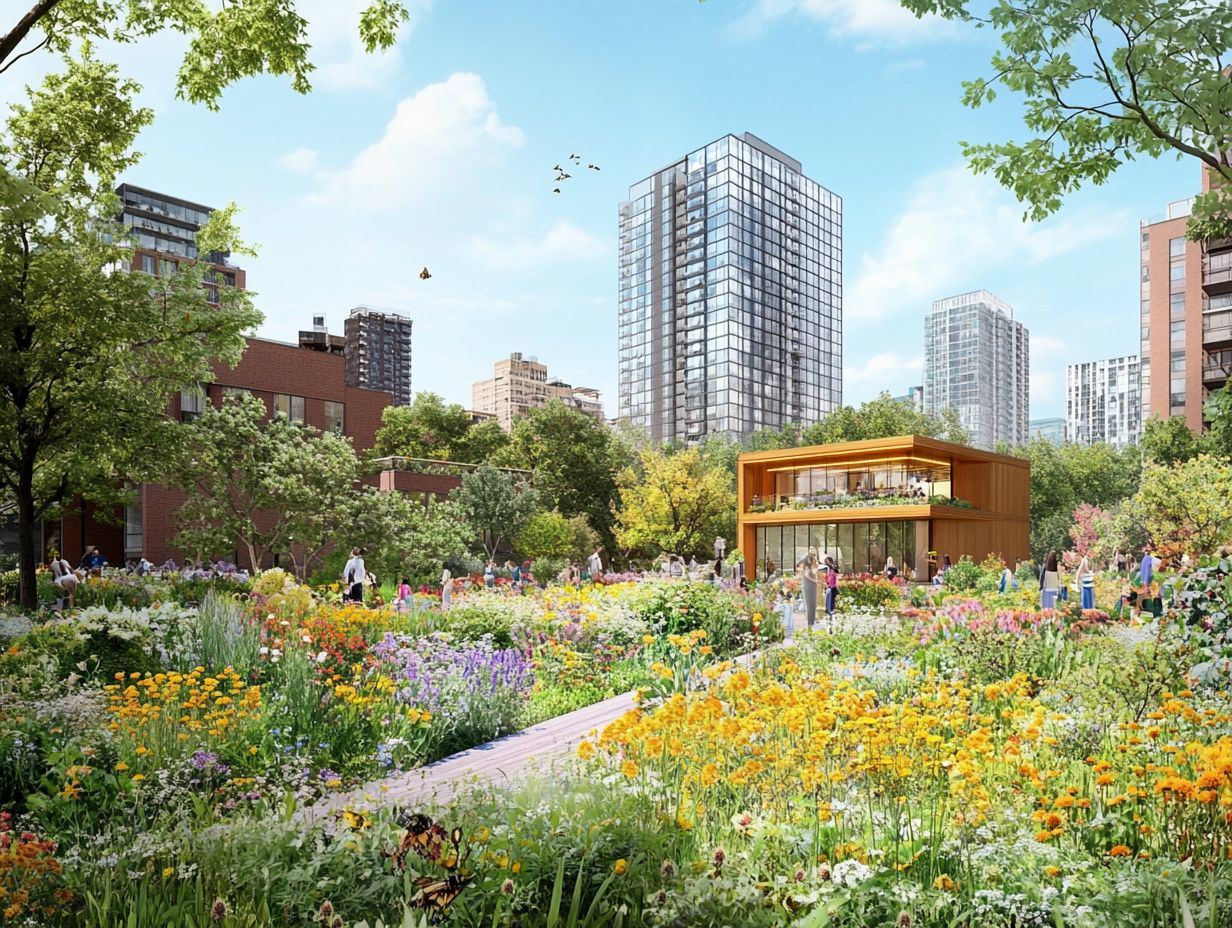
Air-purifying plants are essential in crafting sustainable urban landscapes. They enhance air quality, reduce pollutants, and positively impact the mental well-being of urban communities.
Consider the resilient snake plant, vibrant pothos, and soothing peace lily. Not only do these plants elevate the visual appeal of your surroundings, but they also work diligently to eliminate harmful toxins like formaldehyde and benzene, which are common indoor pollutants.
In bustling urban environments, where pollution tends to run high, incorporating these green companions into public parks, street-side gardens, and even indoor spaces like offices can transform the atmosphere into a healthier sanctuary. Promoting the use of these plants in community initiatives nurtures a sense of belonging and encourages residents to engage in collaborative efforts. This enhances public health outcomes and enriches the overall well-being of the community.
8. Pollinator-Friendly Plants for a Sustainable Urban Landscape
Incorporating pollinator-friendly plants into urban landscapes is essential for promoting biodiversity and nurturing the vital ecosystems that enhance your urban living experience.
These plants do more than just provide food for important pollinators like bees and butterflies; they create vibrant, colorful spaces that can elevate your mood and invigorate the city atmosphere. Choose native flowering species today to attract vital pollinators and boost your urban garden!
Pollinators play a crucial role in food production and the overall health of ecosystems, making it imperative for urban settings to prioritize their support. This harmonious relationship between plants and pollinators enriches urban biodiversity, fostering a more resilient environment that benefits everyone who calls the city home.
9. Vertical Gardening for a Sustainable Urban Landscape
Vertical gardening presents innovative solutions for creating sustainable urban landscapes. This approach maximizes space in densely populated areas while championing eco-friendly practices and elevating aesthetic appeal.
These vertical systems also boost air quality by filtering out pollutants and generating oxygen, fostering a healthier environment for urban residents. Cities like Paris and Singapore have wholeheartedly embraced vertical gardens, showcasing striking installations on buildings and in public spaces.
These green innovations contribute to biodiversity by providing habitats for various species while promoting community well-being. They encourage social interaction and alleviate stress levels. Transform those dull walls into lively gardens that breathe new life into your city!
10. Container Gardening for a Sustainable Urban Landscape
Container gardening offers a practical and flexible approach to cultivating sustainable urban landscapes, enabling you to grow native plants and edible species even within constrained spaces.
This technique not only optimizes the available area but also demands minimal maintenance, making it the perfect choice for busy city dwellers. By incorporating containers into your outdoor spaces, you can dramatically elevate your surroundings, transforming balconies, patios, and small yards into vibrant green sanctuaries.
To embark on this journey, it s crucial to select suitable containers that provide adequate drainage and align with the aesthetic of your area. Choosing plants that thrive in urban environments such as herbs, vegetables, or pollinator-friendly flowers will enhance your space and promote biodiversity, enriching local landscapes.
Get Started on Your Urban Garden Today!
Join community gardening programs or initiate your own urban gardening project. Your efforts can make a difference in creating greener, more sustainable urban landscapes for everyone.
11. Rain Garden Plants for a Sustainable Urban Landscape
Rain garden plants are crucial for cultivating sustainable urban landscapes. They offer effective ways to manage rainwater while enhancing local biodiversity and improving soil quality.
By choosing species like black-eyed Susan, blue flag iris, and common milkweed, you ensure tolerance for saturated soils. These plants attract pollinators and beneficial insects, enriching the ecosystem around you.
Utilizing rain gardens in urban areas significantly reduces the risk of flooding and promotes groundwater recharge, acting as natural buffers against stormwater runoff. This practice is vital for climate resilience, especially as cities increasingly face heavy rainfall and extreme weather events.
Integrating these vibrant ecosystems into urban infrastructure beautifies neighborhoods and creates communal spaces that foster environmental awareness and stewardship among residents.
12. Ground Cover Plants for a Sustainable Urban Landscape
Ground cover plants play a vital role in sustainable urban landscapes. They enhance soil quality, prevent erosion, and add aesthetic value while demanding minimal maintenance.
These diverse plant varieties offer a natural solution for managing stormwater runoff, contributing positively to urban biodiversity. By carefully selecting the right species, city planners can cultivate vibrant green spaces that draw in pollinators and support local wildlife.
Incorporating these plants helps to soften hardscapes, transforming urban environments into more inviting and visually appealing spaces. When paired with other landscaping elements, like native shrubs and trees, ground cover plants create a harmonious ecosystem that flourishes and fosters community well-being and environmental stewardship.
13. Native Grasses for a Sustainable Urban Landscape
Native grasses are essential for crafting sustainable urban landscapes. They contribute significantly to biodiversity, enhance soil quality, and provide vital habitats for wildlife.
These grasses are perfectly attuned to local climates and soil conditions, making them resilient champions that require less water and maintenance than their non-native counterparts. By incorporating native grasses into your landscaping projects, you can cut down your ecological footprint and foster healthier ecosystems.
These remarkable plants play a crucial role in preventing soil erosion and filtering pollutants, thereby improving both urban air and water quality. Integrating native grasses into parks, roadside gardens, and your own yard adds a touch of aesthetic appeal while supporting pollinators and other beneficial organisms.
This creates vibrant communities that flourish both environmentally and socially.
14. Medicinal Plants for a Sustainable Urban Landscape
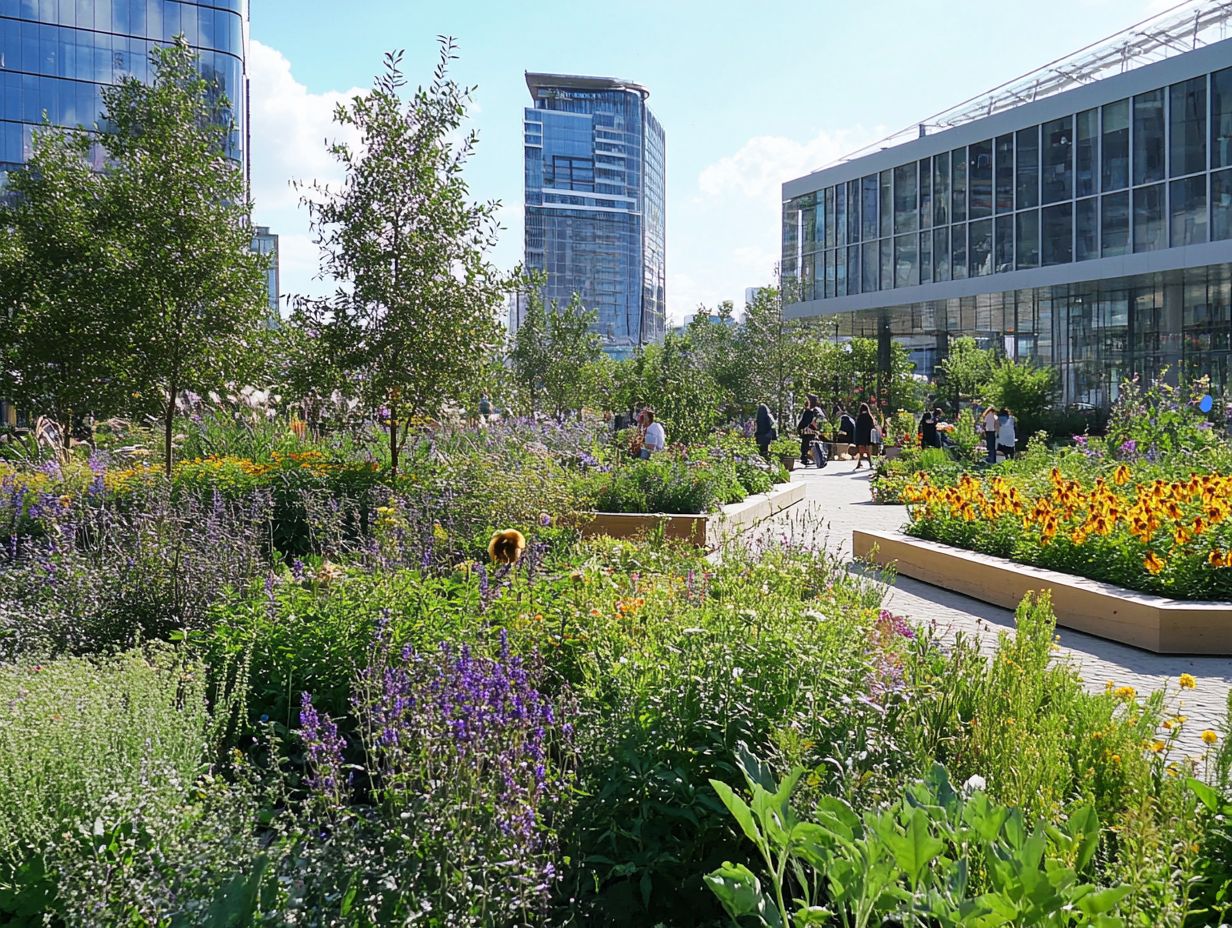
Medicinal plants can profoundly elevate sustainable urban landscapes. They offer you a wealth of health benefits while enhancing biodiversity and enriching your community s wisdom about natural remedies.
Imagine incorporating plants like chamomile, renowned for its calming properties, and lavender, celebrated for its stress-relieving qualities! These additions can cultivate a serene atmosphere in your urban environment.
Community gardens can flourish with these varieties, providing you and your neighbors the joy of gardening alongside the therapeutic benefits these plants offer. Herbs like peppermint and rosemary invigorate your senses and bolster your health.
By promoting workshops focused on harvesting and utilizing these plants for wellness, your community can foster a vibrant atmosphere where both mental and physical well-being thrive. This weaves together a rich tapestry of urban resilience.
Start your own garden or get involved in local community gardening efforts today!
15. Ornamental Plants for a Sustainable Urban Landscape
Ornamental plants significantly enhance the aesthetic allure of sustainable urban landscapes. They play a crucial role in boosting biodiversity and improving air quality within city environments.
These plants are not just about looks. They transform public parks and plazas into vibrant ecosystems that attract essential pollinators, which are key to maintaining ecological balance. Consider species like lavender and coneflower. They deliver a splash of color while providing much-needed support for bees and butterflies, making urban areas more dynamic and environmentally friendly.
By strategically placing these plants, you can create inviting spaces that foster community interaction and encourage outdoor activities. Incorporating trees such as cherry blossoms or magnolias not only offers shade and comfort but also transforms ordinary streets into picturesque pathways.
This harmonious blend of beauty and functionality is vital for nurturing healthy urban habitats.
What Makes a Plant Sustainable for an Urban Landscape?
Sustainable plants for urban landscapes are your allies. They adapt to local conditions, promote biodiversity, and enhance climate resilience, all of which support the overall health of urban communities.
These plants are designed to use water efficiently. They require minimal irrigation once established especially vital in water-scarce areas. With low maintenance needs, they reduce reliance on fertilizers and pesticides, making them a more environmentally friendly choice.
By incorporating native species into urban spaces, you can boost resilience against climate change, create habitats for local wildlife, improve soil health, and decrease runoff.
This approach fosters ecological balance and helps mitigate urban heat effects, ultimately enhancing the quality of life for everyone in the community.
How Can Sustainable Urban Landscaping Benefit the Environment?
Sustainable urban landscaping presents a wealth of environmental benefits that you can’t overlook. These include improved air quality, enhanced biodiversity, and effective stormwater management. Together, these elements contribute to creating healthier urban environments.
These practices aren’t just ideas they’re game changers that deliver real results! For instance, studies show that urban green spaces can cut air pollution by up to 30%, significantly reducing respiratory issues within communities.
When cities prioritize native plant species in their landscaping efforts, they witness remarkable increases in local wildlife populations. Urban bird species become 25% more prevalent thanks to the availability of better habitats.
By implementing effective stormwater management techniques such as green roofs and pavements that allow water to soak through you can reduce runoff by over 50%. This helps mitigate flooding and protects water quality.
The ripple effects of sustainable landscaping cultivate resilient and thriving urban ecosystems, making your environment not just livable, but truly vibrant.
Identifying Key Challenges
Creating a sustainable urban landscape presents a variety of challenges, such as the impacts of climate change, limited space, and the vital need for community buy-in. Addressing these factors is essential for achieving long-term success.
Urban areas often grapple with outdated infrastructure. They struggle to accommodate growing populations and evolving environmental conditions. For example, transportation systems might not handle increased congestion or provide efficient transit options, while green spaces risk being encroached upon by relentless development.
Community engagement is crucial in this context. Without the support of locals, your initiatives could easily falter. To navigate these complexities, consider implementing strategies such as:
- Invest in smart, adaptive city planning that uses technology and values community feedback.
- Create green belts to enhance biodiversity and improve air quality.
- Launch educational programs that instill a shared commitment to sustainability among residents.
Join us in creating a greener, more vibrant city! Discover how you can contribute.
How Can One Incorporate Sustainable Landscaping Practices into Their Urban Garden?
Incorporating sustainable landscaping practices into your urban garden means choosing the right plants and using eco-friendly materials.
Focus on native plants that require less water and maintenance. Techniques like rain gardens manage stormwater runoff, allowing water to soak into the ground instead of flooding nearby areas.
Mulching conserves moisture and suppresses weeds, reducing reliance on chemical herbicides.
Starting out? Introduce a few native species or create a simple rain garden. Expand your sustainable practices over time for a bigger impact.
What Are the Common Misconceptions About Sustainable Urban Landscaping?
Common misconceptions suggest sustainable urban landscaping demands extensive resources, is confined to native plants, or lacks visual appeal.
Sustainable landscaping is not just efficient; it’s beautiful too! It showcases a diverse array of plants that thrive in urban environments. Many urban planners demonstrate how incorporating a variety of species enhances aesthetics and supports local wildlife, fostering vibrant ecosystems in the city s core.
Consider the benefits of xeriscaping, a landscaping method that reduces the need for watering while still delivering a lush, inviting appearance. Cities around the world embrace innovative strategies like vertical gardens and green roofs, proving that sustainable practices can transform even the most concrete-laden landscapes into verdant retreats without sacrificing style.
Frequently Asked Questions
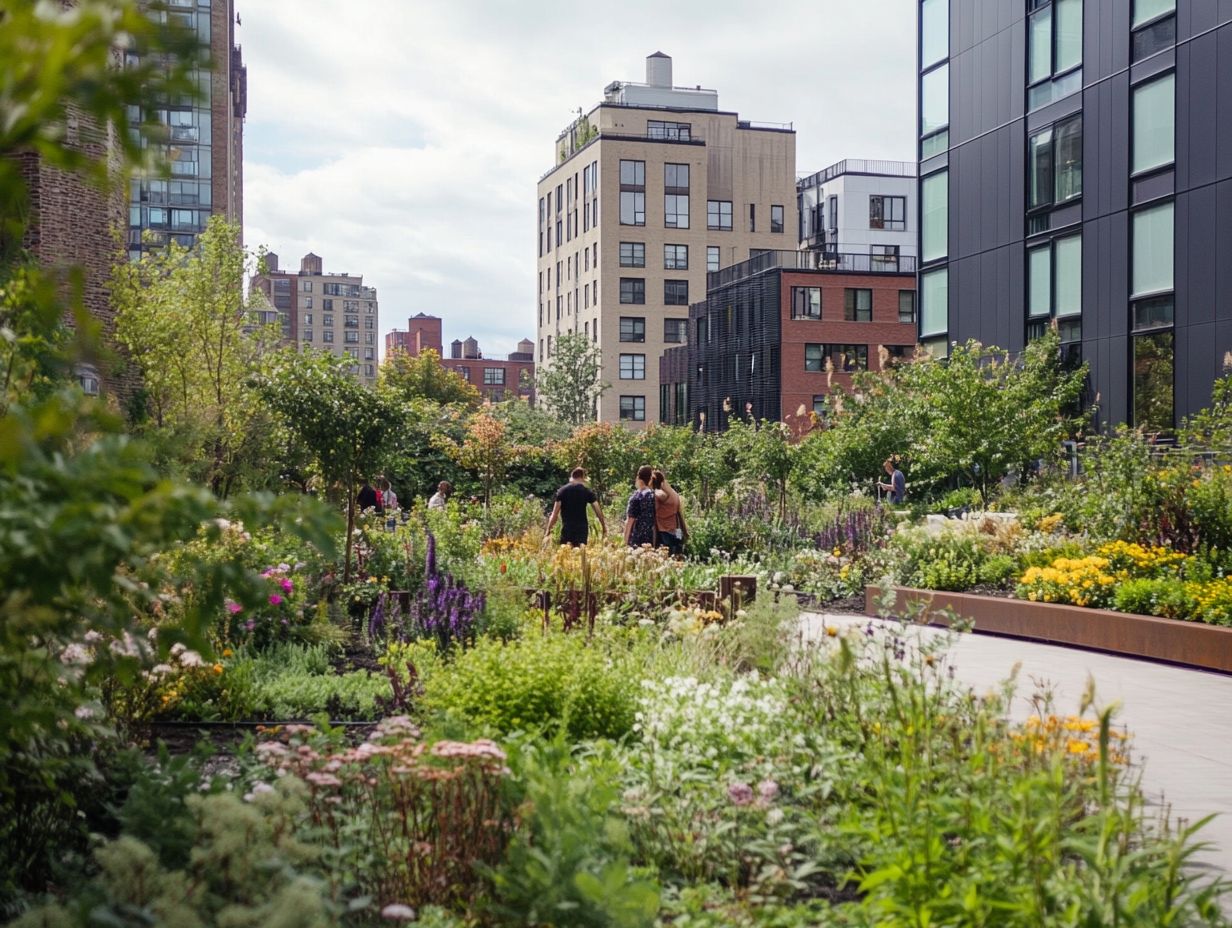
What are the top plants for a sustainable urban landscape?
The top plants for a sustainable urban landscape include native plants, drought-resistant plants, and plants that attract pollinators.
Why are native plants important for a sustainable urban landscape?
Native plants are important because they adapt to local climate and soil conditions, making them more resilient and requiring less maintenance.
Which drought-resistant plants are suitable for an urban environment?
Some suitable drought-resistant plants include succulents, ornamental grasses, and lavender.
How do plants attract pollinators in an urban landscape?
Plants attract pollinators, such as bees and butterflies, by providing nectar and pollen as food sources and creating safe habitats for them to live and breed.
What other benefits do plants provide in a sustainable urban landscape?
Plants in an urban landscape help reduce air and noise pollution, provide shade and cooling, and improve mental well-being.
How can I incorporate these plants into my own urban landscape?
You can incorporate these plants by planning and designing your garden or green space, choosing plants suitable for your location and climate, and properly caring for them to ensure their longevity.
Start your sustainable gardening journey today!

